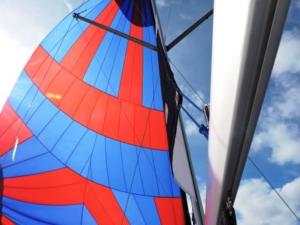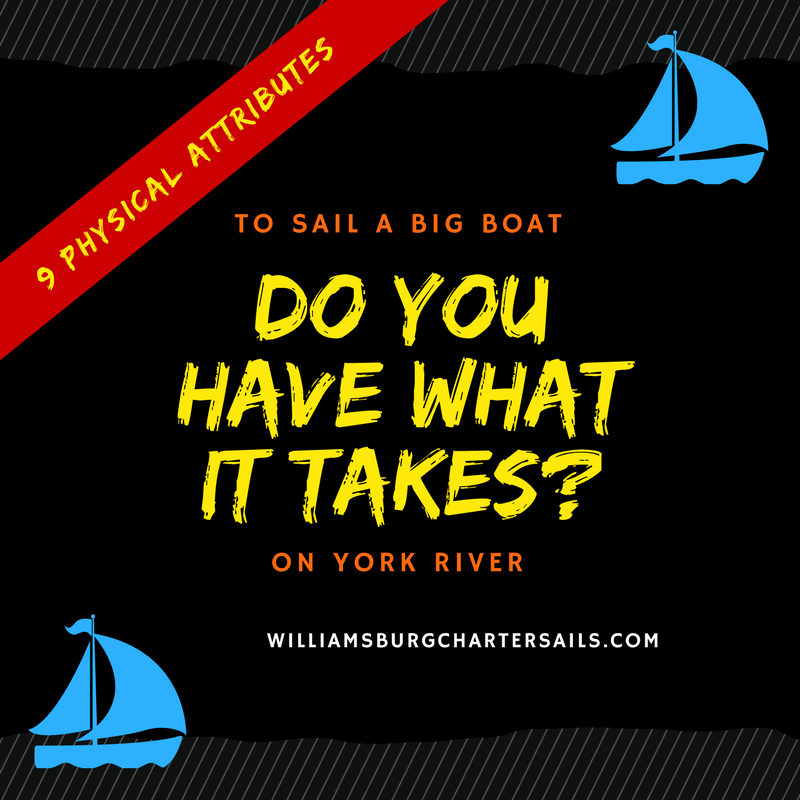What it takes to sail on the expansive York River is grit, determination, skill – or none of the above. You can make it as challenging as you like, or just relax to enjoy the adventure.
-
Mobility
A certain amount of agility is needed to get on and off a boat. The tides run two feet at the extreme, so one has to step up or step down. For those who have ADA requirements, Let’s Go Sail can move the boat to a nearby floating dock, which affords the easiest access by simply crossing a level threshold. I once had two daughters request that for their disabled dad, but he was in better shape than they were.
-
Stamina
Some stamina is needed but not much. Guests with allergic or asthmatic conditions will find the fresh air exhilarating. Those who have trouble moving around will enjoy either one of the catbirds as the best seat in the house. Others use the cockpit seats as the aqua equivalent of a couch, and just sit there enjoying the great outdoors.
-
Stability
 Sailboats have a tendency to lean slightly, or heel. This is normal and expected. Once you get the rhythm of heeling, it’s quite enjoyable. One has to adjust one’s inner gyroscope to maintain stability—or balance. As long as you’re sitting down, it’s an issue. Even dogs get acclimated.
Sailboats have a tendency to lean slightly, or heel. This is normal and expected. Once you get the rhythm of heeling, it’s quite enjoyable. One has to adjust one’s inner gyroscope to maintain stability—or balance. As long as you’re sitting down, it’s an issue. Even dogs get acclimated.
-
Arm Strength
Some arm strength is useful if you choose to pull the lines on the sails. It’s a wonderful experience to run a boat by adjusting the sheets (lines) because it puts the power of the wind in your hands, literally. On the other hand, most people let the skipper run the sheets. Your choice. Mild arm strength is required to run the helm. If the wheel gets stiff, we simply spill more wind to ease the stress.
-
 Hand Agility
Hand Agility
A good grip on the sheets helps turn the sails properly. A sort of ballet takes place as the boat tacks through the wind because the hands are used to pass the sail across the boat. Nothing tricky, just a little experience does the job. The most fun occurs when we put up the spinnaker. What it takes to sail the spinn is modicum of teamwork and timing. People are awed by the sight.
-
Leg Strength
Standing on a boat requires the balance cited above. There is no kicking or lifting required. It’s simply a matter of positioning one’s legs to be ready to pull the sheets. Most people who run the helm like to stand because it gives them a better view. Others sit. It’s a subtle sign of self-confidence when new helmsmen sit because it implies they’ve figured out the physics of sailing.
-
Eyesight
Good vision is vital for noticing hazards on the horizon such as oncoming ships or storms. The skipper is adroit at this and remains alert for all things on the water. I once had a fellow who saw a vague military ship five miles out and correctly described it as a USCG cutter instead of a Navy warship. From that distance, it’s hard to tell. I’ve also had blind people aboard, and they proved magnificent on the helm because their senses are so acute.
-
Hearing
This may be the least required attribute on the water, which explains why deaf people enjoy sailing so much. The only problem for some people is stability because their balance is sometomes affected by deafness.
-
 Curiosity
Curiosity
This is perhaps the greatest attribute on a sailboat, for it opens your eyes to myriad possibilities of adventure and excitement. Feel free to ask questions about the boat’s operation, how sailing works, or life in general on the water. It’s fabulous.
10. Knowledge
Finally, one needs to know the fundamentals of sailing. Jenn Miller has packaged a 7,000-word how-to blog that is full of tips and advice for the novice sailor. Browse her invaluable link here and bookmark it for future reference.
Sailboat Essentials
One of the most frequent questions fielded by Let’s Go Sail is, “What should I wear?” Here are the sailboat essentials for a day’s adventure on vacation.
The easy answer in summer is whatever you have on for the day in the way of shorts and shirt, plus a hat and sunscreen. Temperatures out on the water parallel those found on land.
Spring and Fall are different. From March to April, temperatures are cooler on the water because the York River has had all winter to chill out. Hence the breezes are cooler. Pants and sweaters are the usual garb.
By May, things even out so that what you would normally wear on land works just as well on the boat. That situation lasts through June, July, August and September. Shorts and short-sleeved shirts are the uniform of the day. Swimming off the stern is a pleasant relief on a hot day when the winds are calm.
Come October, the air temperature drops but the river water is still warm from a long summer of sunny exposure. Hence the temperature on the boat is relatively warm and certainly as warm as on land. So no special garb is required. This lasts right into Halloween.
By November, the water has begun to cool so that the air temperature on the river dips slightly below that of land. Long pants and sweaters become the norm along with a light jacket. After Thanksgiving, temperatures on land and water begin to drop, and it’s time to end the sailing season.
Hats and shoes

A hat is vital all year because of the rays of the sun in Summer and the cool air of Spring and Fall.
As to footwear, light-sole Nikes or other running/walking shoes are best. The light soles avoid dark scuff marks on the deck and make for easier navigation. Flip flops are okay except that it’s easy to trip with them. Street shoes, golf cleats and high heels are no good on a boat unless it’s a ferry. Finally you’re also welcome to take off your shoes and let your feet breathe.
For your amusement, check out the YouTube video below, which covers epic sailboat fails from 2014. No worries on the York River, to be sure.
Let’s Go Sail, test yourself
Check rates and pick a day for a sailboat charter. See reviews on Trip Advisor.
https://www.youtube.com/watch?v=m7_vgQa6Fds






